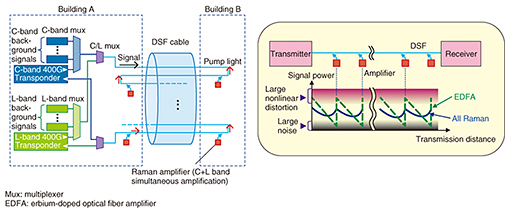 |
|||||
|
|
|||||
|
Short Reports Vol. 15, No. 9, pp. 49–50, Sept. 2017. https://doi.org/10.53829/ntr201709sr1 Successful Field Trial of All-Raman Optical Amplification Technology for Multiband Large Capacity Transmission of 400-Gbit/s Signals in Installed Fiber—Double the Usable Bandwidth of Installed Fiber1. IntroductionNTT recently announced that in conjunction with NTT WEST, it had successfully conducted a field trial on widely installed optical fiber cable. In this field trial, all-Raman optical amplification technology*1 was employed in transmission line repeaters, and 400-Gbit/s signals were transmitted in multiple bands at the same time. Furthermore, we confirmed through this field trial that it is possible to add signals in a new band without affecting the signals in the existing band. The results of this field trial suggest the possibility of achieving ultralarge capacity transmission speeds of up 30 Tbit/s. These speeds, together with the ability to upgrade systems already in use, will be needed to satisfy the demands imposed by communication between datacenters. We are continuing to verify the ultimate performance limits as well as operational aspects, with the goal being to contribute to various fields that require ultralarge capacity transmission.
2. BackgroundOur vision of future communication traffic sees the widespread distribution of high-resolution images and video such as 4K/8K and full-scale popularization of machine-to-machine services. The obvious assumption is that capacity demands will skyrocket, so NTT has been actively pursuing a wide spectrum of studies into achieving ultralarge capacity transmission of signals exceeding 100 Gbit/s. Furthermore, with the recent increase in traffic between datacenters, greater capacity must be matched by greater cost savings. Greater capacity is most directly achieved by using multiple bands (C band + L band etc.), which expands the usable bandwidth of the optical fiber. However, several problems arise if we attempt to transmit multiband signals by wavelength division multiplexing (WDM) over dispersion shifted optical fiber (DSF: dispersion shifted fiber) cable. The zero dispersion wavelength of DSF lies in the extended band (C band), and around this wavelength, the signal is degraded by nonlinear effects (especially four-wave mixing*2). The common solution, unequally spacing the signal wavelengths in the C band, degrades the wavelength utilization efficiency. This is a barrier to further capacity increases.
3. Research resultsOur approach involves applying all-Raman optical amplification technology in both the existing band (L band) and extended band (C band). This approach allowed us to transmit multiple 400-Gbit/s signals (each consisting of two 16-QAM (quadrature amplitude modulation) modulated signals) over 200 km of installed DSF cable with a sufficient transmission margin. The usable bandwidth is doubled by combining the existing band and the extended band (Fig. 1).
Because signal degradation due to four-wave mixing increases with the signal’s optical power, low optical power levels are essential to suppress nonlinear effects. All-Raman optical amplifiers are superior to general EDFAs (erbium-doped optical fiber amplifiers), as they allow low signal transmission power to be used. Our approach also improves frequency utilization efficiency in the C band by equally spacing the wavelength intervals. The use of Raman amplifiers raises safety issues because high power pump lights are used. Our field trials were designed to fully comply with IEC (International Electrotechnical Commission) standards. Furthermore, we confirmed that appropriately controlling the Raman amplifiers made it possible to add C band optical signals without altering the transmission quality of the L band signals. This confirms that capacity can be upgraded without disrupting L-band services already in use. For InquiriesPublic Relations, NTT Information Network Laboratory Group Email: inlg-pr@lab.ntt.co.jp |
|||||

